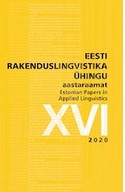VÄLJAMÕELDUD MORFOLOOGIAREEGLI OMANDAMINE 8-AASTASTEL LASTEL
ACQUISITION OF AN ARTIFICIAL MORPHOLOGICAL RULE BY 8-YEAR OLD ESTONIAN CHILDREN
Author(s): Reili Argus, Eveli MakkoSubject(s): Theoretical Linguistics, Phonetics / Phonology, Morphology, Language acquisition, Finno-Ugrian studies
Published by: Eesti Rakenduslingvistika Ühing (ERÜ)
Keywords: language acquisition; inflectional morphology; grade alternation of verb stem; animacy of subject; comprehension test; explicit instruction; individual differences; Estonian;
Summary/Abstract: The aim of the current article is to present the first results of an experiment conducted with 8 Estonian children and 4 young adults as a control group for testing the acquisition of an artificial morphological rule (AMR). Each participant was individually trained in 10 consecutive daily training sessions (1–4 days apart) and re-tested for retention after an interval of one month. The experiment was based on the experiment conducted by Sara Ferman and Avi Karni (2010, 2014) but was shortened and adopted for Estonian language. The AMR was designed to be analogous to the morphophonological rules of Estonian grammar and participants were supposed to add different verbal suffixes depending on the animacy of the subject. Training occurred through exposure to and use of the AMR in the performance of a judgment task wherein the participants were instructed to make a forced-choice (correct – incorrect) response. Both the number of correct answers and reaction time were measured. There was no explicit instruction on the nature of the AMR at any time during the training. As a result of the experiment, 6 of the 8 children acquired the rule by the third session, their performance reaching to the level of approximately 85% of correct answers, while 2 children did not acquire the rule (the answers of one child were random from the first until the last session, the second child just decided that one of the suffixes was correct in every sentence). The increase in the number of correct answers and decrease of reaction time demonstrated a similar pattern in children’s and young adults’ results. The adults’ performance was 10% superior to that of the children. The results show that children did not give more correct answers to verbs occurring with animate subjects, nor did they perform better with verbs having different morphophonological structure (grade alternation of the verb stem).
Journal: Eesti Rakenduslingvistika Ühingu aastaraamat
- Issue Year: 2020
- Issue No: 16
- Page Range: 23-41
- Page Count: 19
- Language: Estonian

